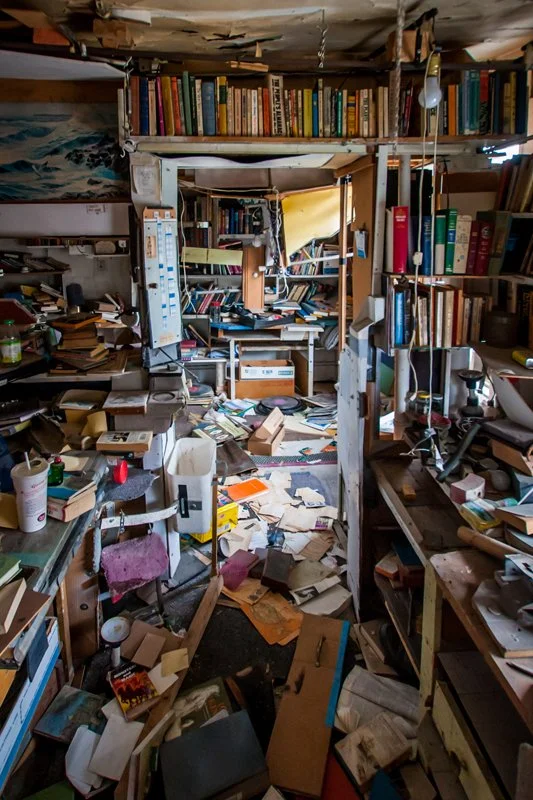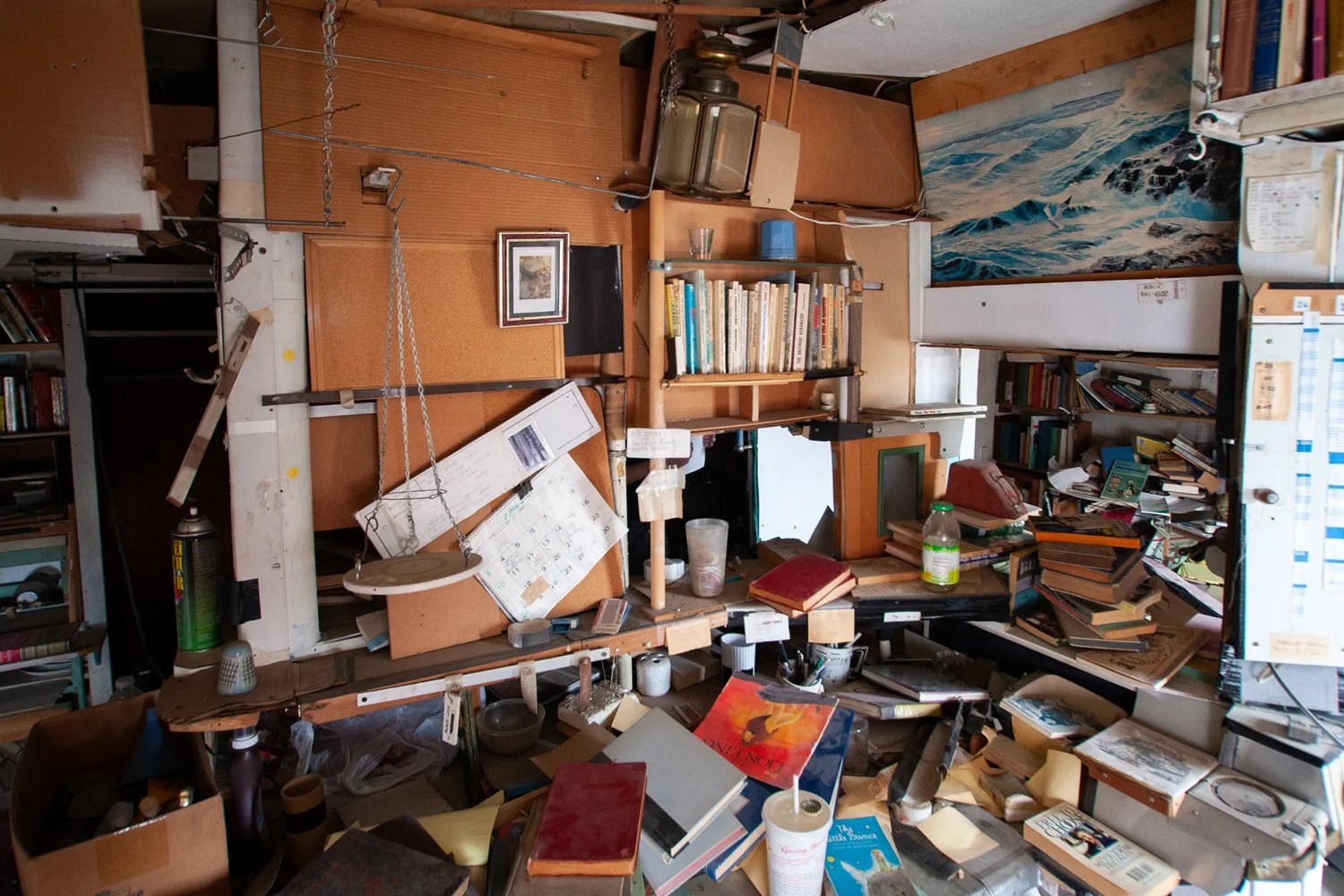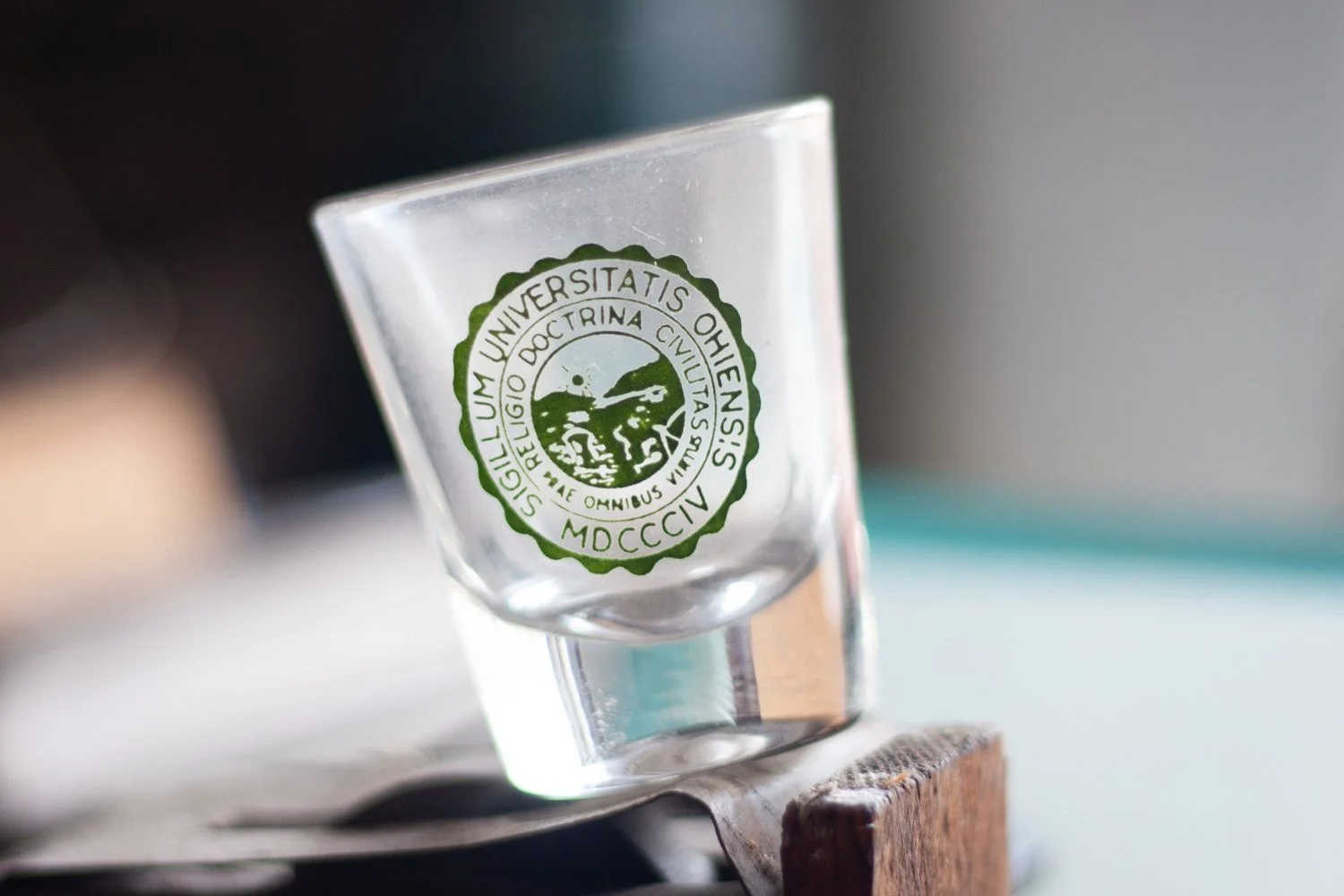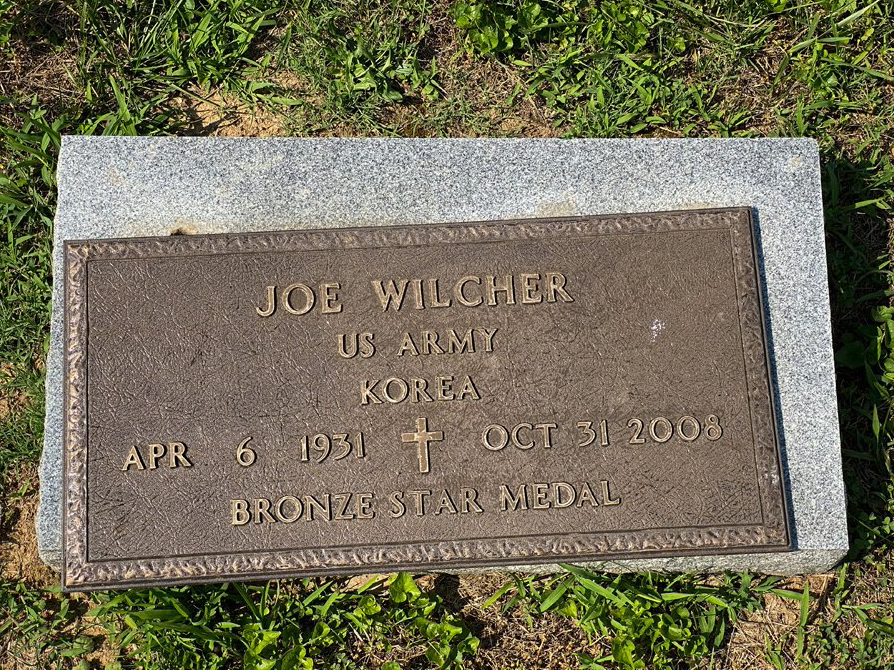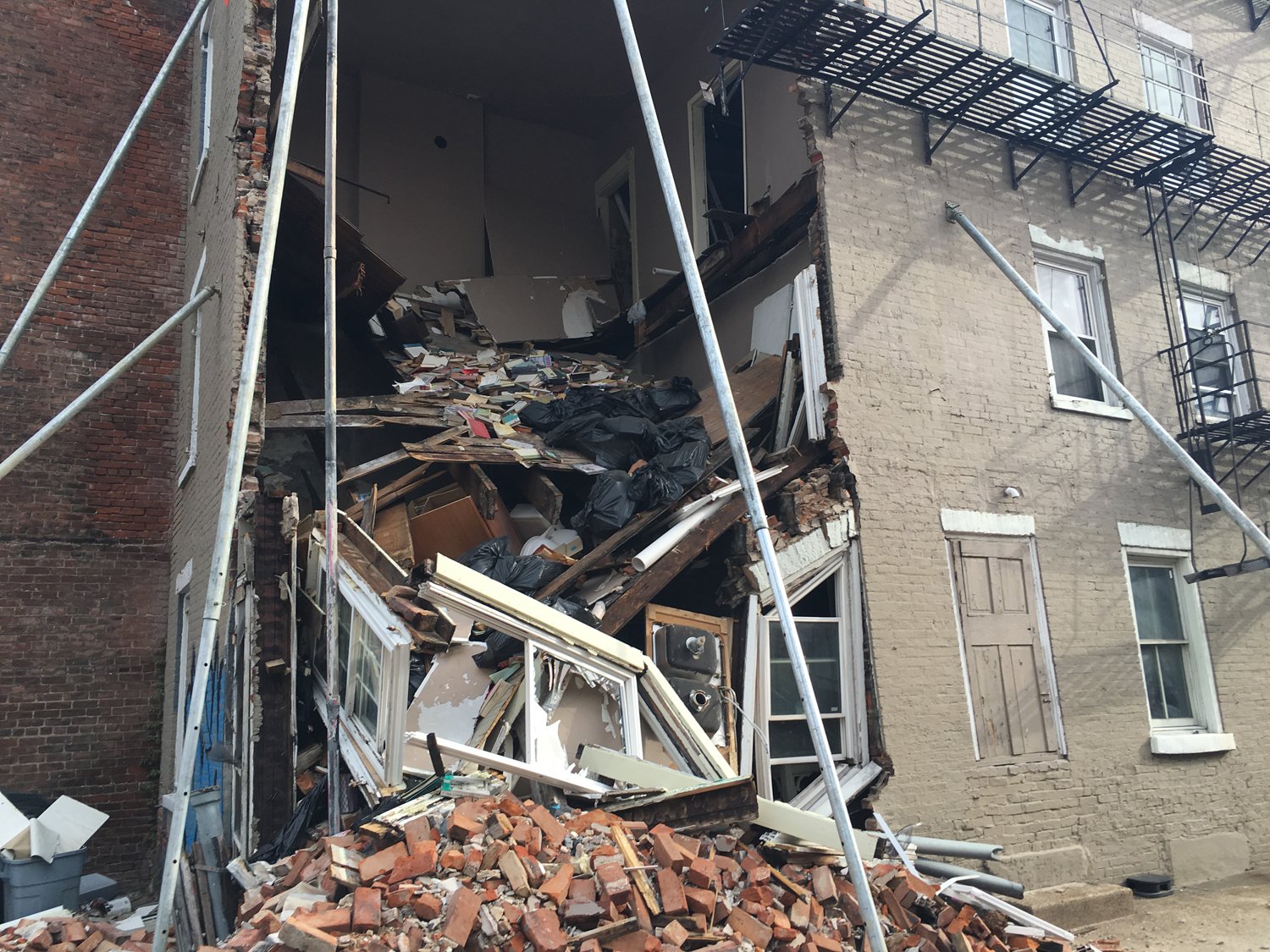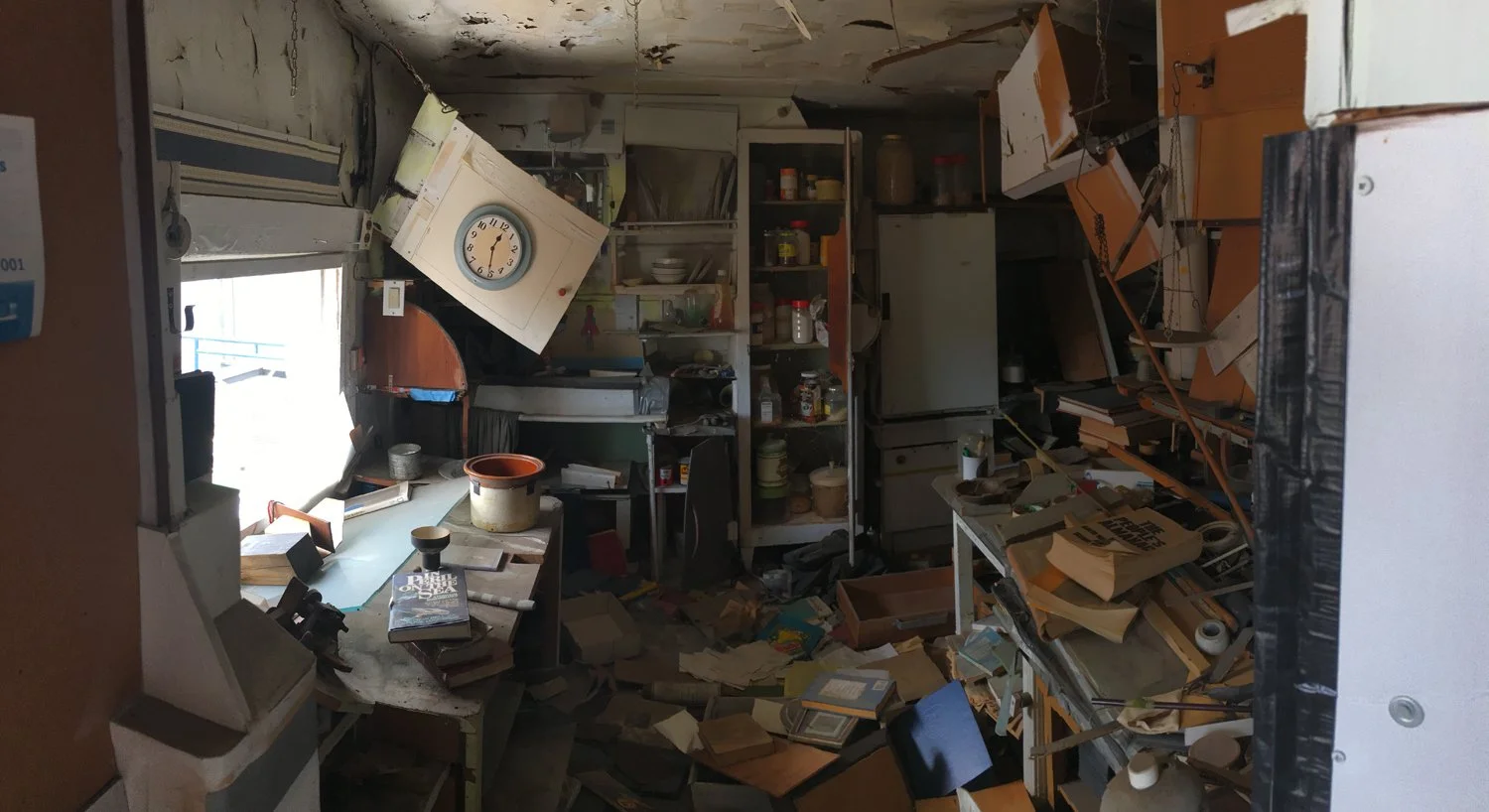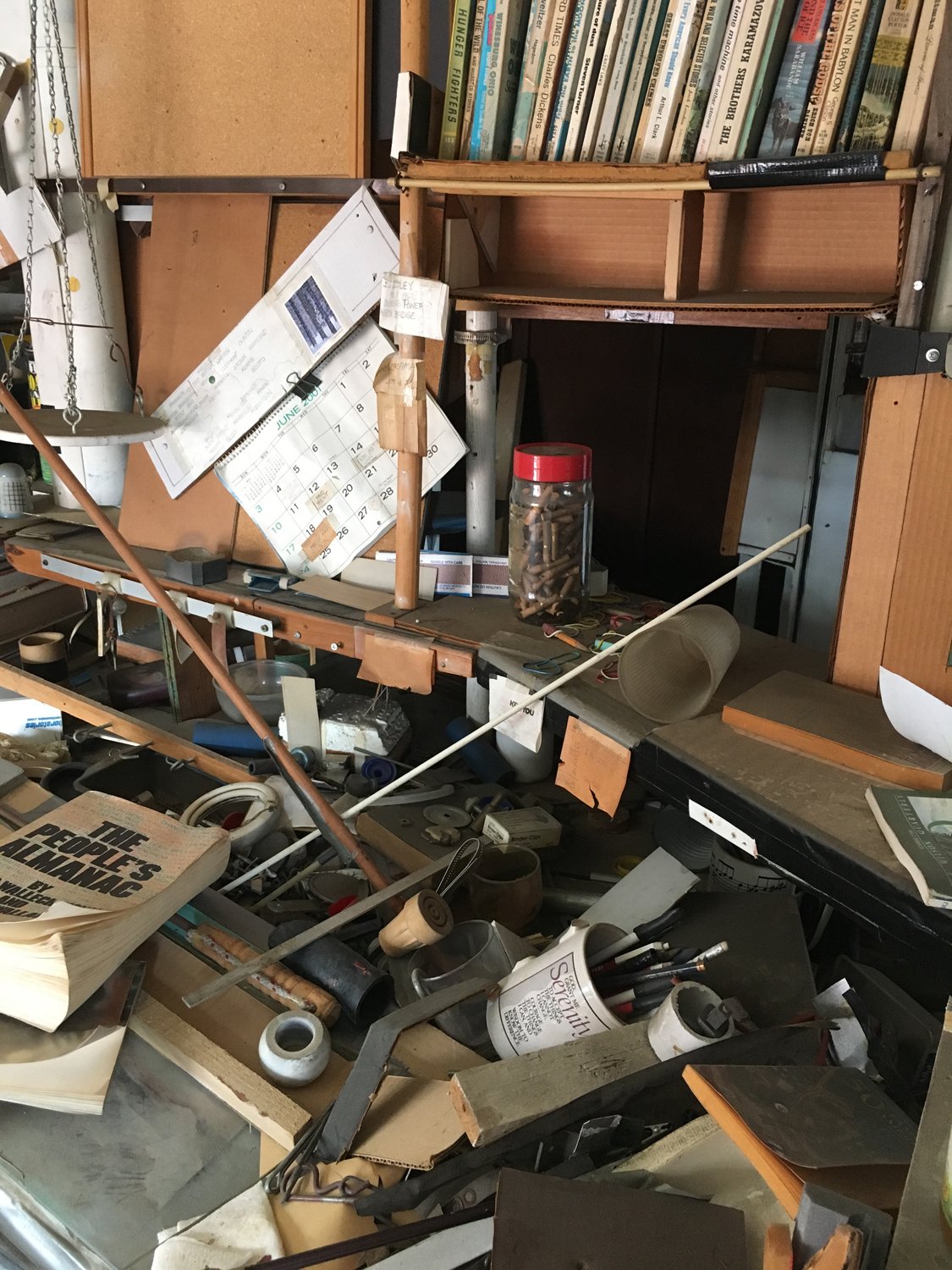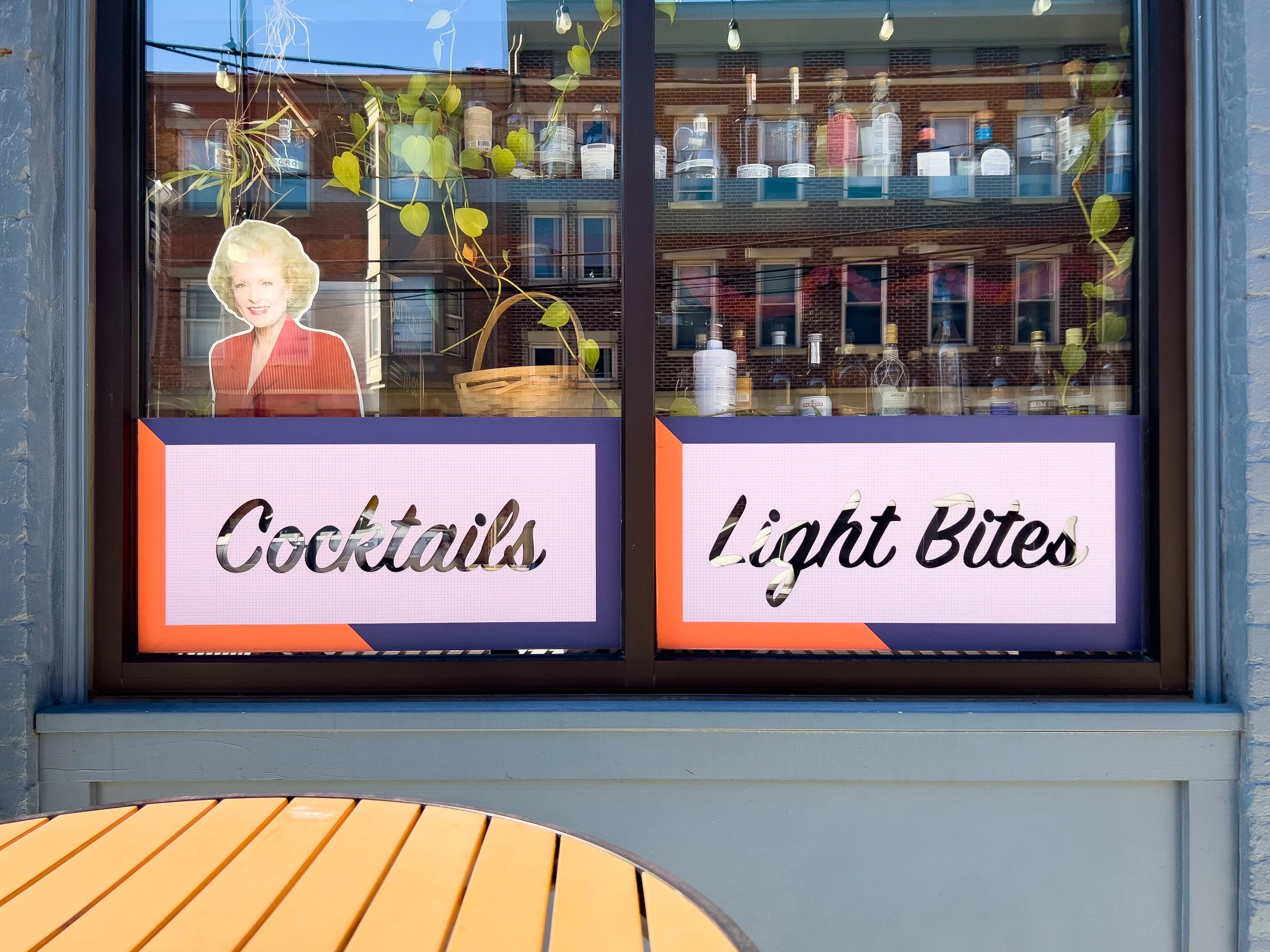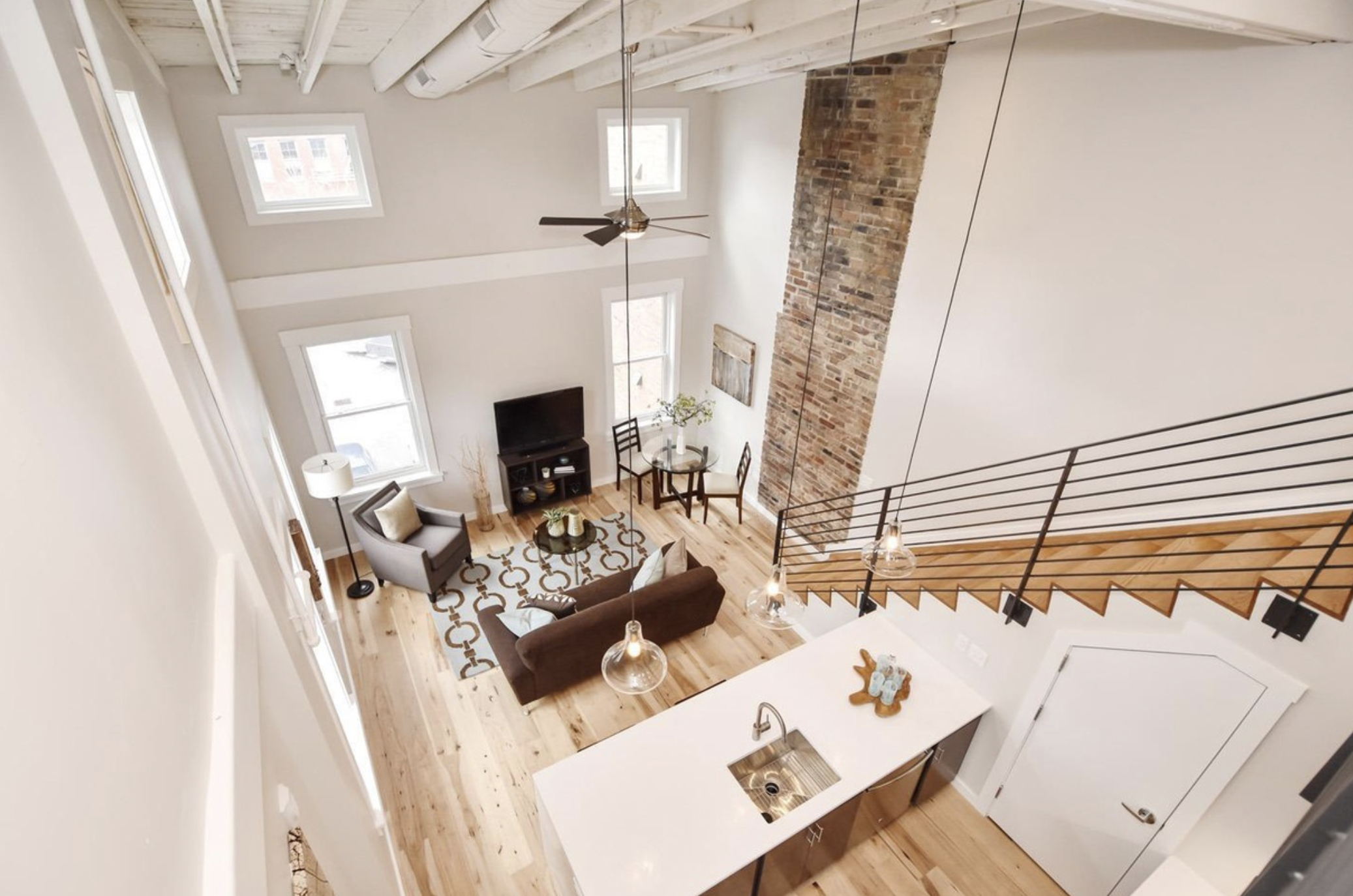Things Left Behind
It was one of those nights where I drank too much gin and started talking to the dog, my poor canine companion forced to listen as I attempted to rationalize irrationality. A moment where I could still recognize how objectively fine life was, but couldn’t bring myself to truly accept such detachment. Having sunk to the floor of my apartment, I looked up and saw my bookshelf. Neatly organized when I’d moved in a year and a half ago, it was now covered in dust and crammed with books on top of books—the majority of them having never been read in any of the living spaces I’d trucked them to. Each title waiting for its chance to sit amongst the chosen: the ones dog-eared and bookmarked by Chinese restaurant menu flyers, resting in half-consumed states next to my bed in the other room. That area isn’t just a bedroom. It’s also my office, storage space, and yoga studio. I only consider it another room because there’s technically a door which separates it from the dual-purpose living room/kitchen.
Dog and bookshelf. 2022.
I knew how tiny and cramped this place would be when I signed the lease and was more than ok with that. I don’t want to sound as if I’m complaining—I do appreciate this space, but there have been times when it has felt suffocating. The exact antithesis of what I’d hoped for it to be when I moved in. Often, it can seem like loneliest place in the world. Even when I walk away from it and straight into the heart of a city.
Encouraged by the gin, I fell down on the bed as the dog claimed her preferred, yet inconvenient, spot in the center. Two questions then came to mind.
The first: “Have I always been this unhappy?”
To quickly answer that: no. While I sometimes worry that the work I share here may sound overly morose, there are many good things in my life. Those, however, don’t require as much processing or demand the energy of reflection. The things that do need such effort, however—the thoughts that cause me to type and scribble away until some sense of stability can be found—often arrive without warning. Gin or no gin. And when they do, they lead to catastrophizing or telling myself self a story that may only be partially true. They lead to questions like my second one here. One that’s, frankly, unfair to ask.
“Have I become Joe Wilcher?”
. . .
I never knew Joe. I have only this idea in my head, based off memories and photographs from nearly 14 years ago. When I was 20 in 2009, I’d been authoring a website entitled Queen City Discovery for about two years. The focus of that digital publication was stories of history told through the lens of “urban exploration,” or, adventures into abandoned places. On a Spring afternoon back then, a friend called and invited me to come see something. Her boyfriend at the time was working with a crew to clear out a building that was being prepped for renovation. Such rehabilitation work wasn’t uncommon at the time, but the concept was rapidly gaining momentum in a specific urban neighborhood of Cincinnati. At the time, I naively described the story as having taken place in “the once notorious, now ever developing Over-The-Rhine neighborhood.” That statement isn’t entirely inaccurate, but it lacks a great deal of context. A context I had only begun to try and understand back then.
1223 Walnut St. and “The Ice Cream Palace.” 2009.
“The Ice Cream Palace” was busy hawking soft serve from the first floor windows when we arrived. Inside and directly above the dessert stand were a few residential units. Ali, Chap, Lisa, and I were led up to the one in the attic, a dwelling that had probably never aligned with any modern fire codes or regulations, but had still been a home nonetheless.
Joe Wilcher’s apartment. 2009.
The space was gripping, not just as something to document visually, but to take in personally. Shelves had been built into almost every available space and lined with a seemingly endless collection of books. There were also a great deal of personal belongings that had been left behind—from war commendations to social security paperwork, clothing, and handwritten notes. All of it set to be pulled out and hauled away.
Possessions left behind in Joe’s apartment. 2009.
The man who had once lived there was named Joe Wilcher. A discarded bus pass and several other lingering documents corroborated that. The story we got was that Joe had apparently just up and left one day, allegedly relaying to his landlord that he “couldn’t take it anymore.” If the calendar on the wall was to be believed, it seemed as if Joe’s last days in his attic apartment were in June of 2001.
Joe’s bus pass and calendar. 2009.
Eight years later, the four of us were quietly meandering around the space, attempting to display some sort of impulsive reverence for what it was, but not entirely sure how to process it. We were, after all, digging through what had been someone’s home and what still might technically be their possessions. Sure, everything was going to be thrown out, but this wasn’t some estate sale.
A discarded copy of 1984 by George Orwell. 2009.
Told to take whatever we’d like, we each grabbed a few books to add to our personal collections. The only other thing I grabbed was a shot glass bearing the seal of Ohio University.
The Ohio University shot glass. 2009.
After we left, I authored a story about the experience entitled “The Unsolved Mystery of Joe Wilcher.” The “mystery,” however, was partially solved by someone in the comments section just a few days after publishing.
“WILCHER, JOE
Birth: 06 Apr 1931
Death: 31 Oct 2008”
Joe had apparently passed away in Covington, KY. Right across the river from his former library apartment.
Over the years, that 2009 story and “Joe” would occasionally come to mind. While out on the road in July of 2020, I ended up near Joe’s final resting place: a cemetery plot in Hustonville, KY.
Joe’s grave. Hustonville, KY. 2020.
From that story:
“I do what I guess feels natural in a cemetery (if television shows and movies are to be believed): I talk. I don’t really know what to say and the sound of my own voice after hours of quiet sounds foreign to me. Still, the impulse to speak seems right even if I have no idea where Joe’s eternal spirit might be or if it would even care. Nevertheless, I say what comes to mind and try to be sincere. It feels ridiculous, yet comforting.”
The Joe of my mind, the one in my head when I visited his grave, was born only from available information, exaggeration, and speculation that seems insensitive in hindsight. All of it was fueled solely by the things left behind and the photographs I made combined with the stories I told myself. Stories like the one of the shot glass I’d found in his apartment.
At the time of publishing the original article, I was waiting to start at a new school after just having transferred away from Ohio University, a place I didn’t much care for. Like the opening sentiment here, things were objectively good in my life when I resided and studied in the small town of Athens, Ohio, but I was miserable. Even after I left, I debated if I’d ever be happy.
Joe’s apartment struck a chord because it reminded me of the tiny, single dorm room I’d occupied at OU. A place packed with my possessions that could feel suffocating, yet empty. In my 2009 mind, Joe and I had to have shared a kinship of isolation and personal clutter. Finding a shot glass with my former school’s logo only reinforced that, like some sort of sign from the universe.
The place I currently occupy also occasionally reminds me of that old dorm room. The windows creak in the same way, the laundry machines clatter in a similar fashion, and sometimes I’ll catch an “old building” scent in the hallway that brings me right back to that awful freshman year. After the physical reminders began evolving into emotional ones, I started thinking again about Joe, at least the Joe I’d created in my mind. Someone surrounded by the things they held dear, yet very much alone.
As I said earlier, though, that’s entirely unfair. To both Joe and myself, really. I didn’t really know him and my apartment isn’t exclusively some lonesome abode. It’s the base of a life far better than the ones I’ve left behind. A locale where, yes, I’ve had too much gin and talked to the dog, but also the place where I’ve had too much gin and danced with the dog. It’s mine. Even if it’s bound by yearly lease agreements and the economic whims of property owners. An ephemeral slice of the city to call my own if only for a moment.
Still, I try go get away from it every now and then, working out of nearby coffee shops and bars in the hopes that I’ll find interesting people to strike up a conversation with—as if I’m not engaging in some isolating activity, hunched over a keyboard and sipping down whatever’s in the glass, can, or mug at my side.
. . .
The particular bar I’m sitting at now isn’t one of my regular spots. In fact, I’ve never even been here before, but I’ve heard good things.
“You can never go wrong with a ‘Gansett,’” said the kind bartender after I ordered.
Narragansett seems to be the latest slightly-outside-the-mainstream-but-still-cheap-and-low-brow-enough-to-not-be-pretnetious-or-too-basic-beer challenging PBR and High Life for the title these days. He handed me a fresh pint before heading over to the other side of the bar, shaking a mixer near what had once been one of “The Ice Cream Palace’s” walk-up windows. Looking up from the barstool, it seems as if the second floor was merged with the first at some point to create a more open space. There’s a few local artists offering their creations at the tables by the entrance as part of a “holiday market,” the event bringing in a few folks on a weeknight. The place is dim, with candles on the bar top, and “New Slang” by The Shins is playing on the speakers. A song which once appeared in the film “Garden State” and caused many then-fifteen year olds like myself to go out and buy “Oh, Inverted World” in 2004.
The menu is stylized to look like a teen gossip magazine from the 90s/early aughts. A piece of artwork rife with millennial-era references to people like Ashlee Simpson and things like floppy disks. That’s not to poke fun at the place, I like their style. It’s just to say that they clearly understand the whims of their key demographic. And I wonder how many years I’ve got left until I age out of being a target for nostalgic marketing. Especially in this area of the city that now seems to be in the midst of an identity crisis. Is this still a neighborhood or is it now an “entertainment district?”
Looking back up at the ceiling once more, past the projection of video games on the wall, I wonder whatever happened to Joe’s apartment. Is it some luxury condo now? The kind of place that’s only a few blocks from where I live, but much nicer and something I could never afford? Or is it still an attic? Maybe one with books still lining its walls.
I send off a couple of emails in search of answers, pay my tab for four Narragansetts and leave.
. . .
Sara Bedinghaus, Development Manager of the Cincinnati Center City Development Corporation (3CDC), is kind enough to call me back. A few years ago, she’d worked on a project that saw the renovation of Joe’s building after the 2009 plans were abandoned. Her employer had actually acquired the property in the wake of its March 2016 partial collapse. After we chat about a mutual respect for history, cities, and urban planning, Sara sends over some photographs.
1223 Walnut after its partial collapse. Photograph by Sara Bedinghaus, 2016.
By the time of the collapse it seems, many of Joe’s things still remained in the attic as evidenced by Sara’s images:
Joe’s former apartment following the partial collapse. Photograph by Sara Bedinghaus, 2016.
Some of Joe’s belongings including the calendar seen in 2009. Photograph by Sara Bedinghaus, 2016.
Even in its crumbled state, the space was also memorable to Sara. As she later told me—she’s come across a lot of interesting spaces in her line of work, but to her, Joe’s apartment was “truly captivating.” It was a place that resonated with her. Through the things Joe left behind, he was still connecting people via his possessions and personality.
Homemakers Bar and The Stafford. 2023.
These days, the 1860 building known as “The Stafford” doesn’t just host a watering hole called Homemakers Bar on the first floor, it’s also been combined with another nearby building for residential use.
Homemakers Bar patio. 2023.
In the end, the attic was removed to create a lofted apartment. Per a real estate listing, it eventually looked like this:
The attic and top floor combined to make a lofted residential unit. Photograph via RedFin.
As for the real Joe, there are numerous things I now know to be true. Not just from what was left behind and a re-studying of the details in my original photographs, but thanks to the kindness of Debra Wilcher—Joe’s niece who reached out awhile ago after coming across the original story:
Joe and his twin sister, Jean, with their grandparents in Jacktown, KY. Photograph courtesy of Debra Wilcher.
Gene “Joe” Wilcher was born in Michigan in 1931, a twin and one of six children. He served in the United States Army during the Korean War and was the recipient of a Bronze Star, indicating that he performed heroically during combat. He received an honorable discharge at the conclusion of his military service. He was never the same after the war.
Joe’s oldest sister, Virginia (front, left) and other family members at the Hustonville, KY cemetery. Photograph courtesy of Debra Wilcher.
Joe was an iron worker at one point and came to make Cincinnati his home for many years after having hitchhiked across the country several times. Aside from his penchant for books, he was also a history buff, and had a fondness for flea markets. He used the local bus service and also seemed to have enjoyed hand rolling his own cigarettes.
Books, hand-rolled cigarettes, and handwritten notes found in Joe’s apartment. 2009.
He was loved and admired by his niece, someone who describes him as very intelligent and interesting. A man who “lived life on his own terms” and “marched to the beat of his own drum.”
Joe’s urn at the Hustonville, KY cemetery. Photograph courtesy of Debra Wilcher.
A note on the back of the urn photograph from Joe’s sister, Virginia, describing how she was bringing some of the ashes back to California to be sprinkled on the grave of Joe’s twin sister. Photograph courtesy of Debra Wilcher.
According to Debra, had I been able to meet Joe, I would have made a lifelong friend.
. . .
Everyone’s got a sense of organization that makes sense to them. Joe certainly did, and so do I. Everything I own is crammed into this tiny apartment, organized into boxes and kept track of via a manifest. Still, my personal system only works so well. I found the correct box, but doing so kicked up a lot of dust and once I got the damned thing open, I had to dig through it just to get to the smaller boxes at the bottom. I even ended up tripping over my tool box and knocking things everywhere. Kneeling down painfully on tiny screws, I finally cut open the boxes holding my collection of shot glasses. And after all that, among all the ones I’ve been collecting since I was a kid—I still couldn’t find the one I took from Joe’s place, the one marked with the seal of Ohio University.
Shot glasses from storage. 2023.
I thought that maybe, to end this story, I’d take it back to the bar that now sits in his former building and toast to him. Or, I’d pour myself a drink on the fire escape where I like to sit and read, a ledge similar to the one seen at Joe’s place in my original photographs. But perhaps it’s best that the glass is now long lost (or just lost to a different box). I like to say that I never really believed in signs from the universe anyways, but maybe this is just another sign itself (and maybe I should stay open to these supposed signs).
The action of digging around through my stuff felt reminiscent of that Spring afternoon back in 2009, the one spent in an abandoned attic apartment. Each thing I’ve kept with me over the years has some sort of significance and I firmly believe that given how many times I’ve parsed through it all while moving through different chapters of life. I don’t really see those physical possessions as my metaphorical remains, however. Rather, this website and its previous life seem to fill that role for me. And if all of that is only temporary too, living and dying at the whims of digital storage, I hope it can positively affect someone in the time that it manages to stick around. In a way similar to how Joe Wilcher affected me via what he left behind.
I’ll never have the chance to meet Joe, but he still appears in my mind. Except now, he’s no longer just a story I’m telling myself. And if I have in fact become Joe Wilcher, as I once drunkenly wondered—well, that’d be an honor.
Thank you, Joe.
Sincerely,
Ronny Salerno
. . .
Special thanks to Sara Bedinghaus and Debra Wilcher for their kindness and assistance with this story.
. . .
The original, 2009 story about Joe’s apartment can be found here while the 2020 road trip (which featured a stop at his grave) can be found here.
Since 2007, the content of this website (and its former life as Queen City Discovery) has been a huge labor of love.
If you’ve enjoyed stories like The Ghost Ship, abandoned amusement parks, the Cincinnati Subway, Fading Ads, or others over the years—might you consider showing some support for future projects?


